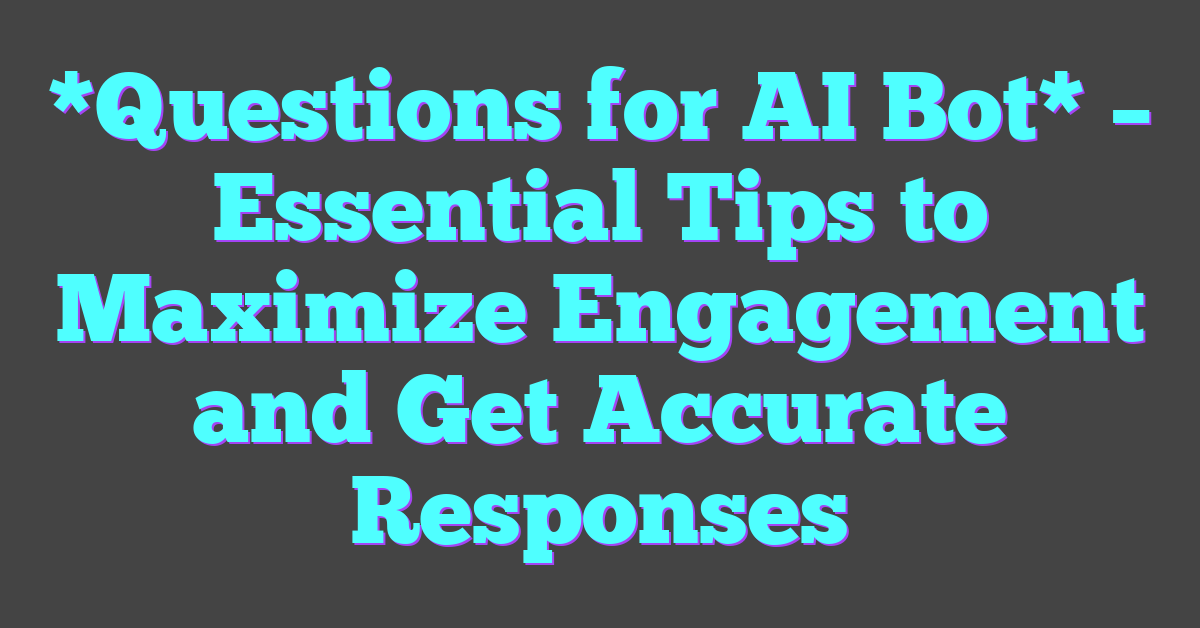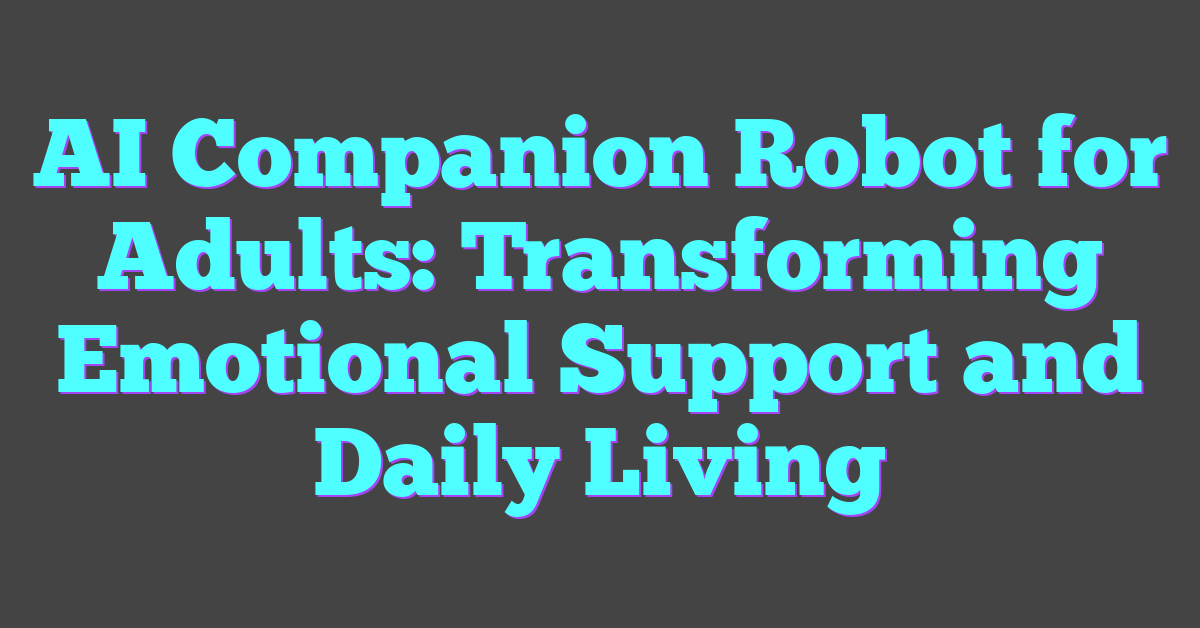Ever wondered how to get the most out of your interactions with AI bots? With their growing presence in customer service, personal assistants, and even entertainment, knowing the right questions to ask can make all the difference. These digital companions are designed to help, but the key to unlocking their full potential lies in how you engage with them.
From troubleshooting tech issues to finding the best recipe for dinner, AI bots can handle a wide range of queries. However, not all questions yield equally useful answers. Crafting effective questions can enhance your experience and ensure you get the information you need quickly and accurately. Let’s dive into some tips and examples to make your conversations with AI bots more productive and enjoyable.
Understanding Questions for AI Bots
Understanding how to pose questions to AI bots significantly impacts the utility of AI in various fields. Crafting effective questions ensures that users receive accurate and useful responses for tasks in customer service, personal assistance, or entertainment.

Types of Questions You Can Ask
AI bots can manage a diverse range of questions, categorized into several types:
- Informational Questions
Users often ask these questions to obtain information or insights. Examples include, “What’s the weather like today?” or “How does photosynthesis work?” - Procedural Questions
These questions seek guidance on completing tasks. Examples are, “How can I reset my password?” or “What are the steps to bake a cake?” - Personalized Questions
AI bots can tailor responses based on user preferences or historical data. Users might ask, “What’s on my calendar for today?” or “Recommend a good Italian restaurant.” - Clarification Questions
These inquiries ask for further details on a previous conversation. Examples include, “Can you explain that in more detail?” or “What do you mean by that?” - Conversational Questions
Users engage in more natural dialogue with AI bots, asking questions like, “How are you today?” or “Tell me an interesting fact.”
Communicating Effectively with AI Bots
Effective communication with AI bots involves several key strategies:
- Be Specific
Specific questions yield more accurate answers. Instead of asking, “What’s happening today?” ask, “What events are scheduled for today in New York?” - Use Simple Language
Bots process simpler language more efficiently. Avoid complex sentences and jargon. Instead of, “Elaborate on the biochemical processes in cellular respiration,” ask, “Explain cellular respiration.” - Provide Context
Offering context helps bots understand user intent better. For example, “I need help with my account” can be improved to, “I need help resetting my password for my email account.” - Stay Relevant
Keep questions aligned with the bot’s known capabilities. For instance, asking a customer service bot about the weather may not yield relevant results. - Use Keywords
Incorporating key terms of the subject matter can guide bots to more accurate responses. Instead of a general query like “Help with my computer,” ask, “Help with installing software on my computer.”
Applying these strategies enhances interaction quality with AI bots, promoting more productive and satisfying experiences.
The Role of AI Bots in Daily Interactions
AI bots have revolutionized daily interactions, efficiently handling tasks in multiple domains, notably customer service and personal assistance.
How AI Bots Enhance Customer Service
AI bots expedite customer service by managing inquiries, resolving issues, and providing information. These bots operate 24/7, offering immediate responses and reducing wait times. They handle a large volume of queries without fatigue, enhancing the efficiency of customer support teams. According to an Oracle report, 80% of businesses use chatbots for customer interactions. Examples include handling order tracking, processing refunds, and answering FAQs.
AI Bots in Personal Assistants
AI bots in personal assistants streamline daily tasks, from scheduling to information retrieval. Apps like Google Assistant, Siri, and Alexa utilize AI to set reminders, provide weather updates, and control smart home devices. These bots learn individual user preferences, offering personalized experiences. For instance, an AI assistant might suggest a music playlist based on the user’s listening history.
Key Features to Consider When Using AI Bots
When integrating AI bots in various applications, key features must align with your goals. Understanding their capabilities and limitations ensures optimal performance and user satisfaction.
Language Processing Capabilities
Natural language processing (NLP) capabilities determine an AI bot’s effectiveness in understanding and generating human-like text. High-quality AI bots leverage advanced NLP models, such as GPT-4, which can comprehend context, detect nuances, and generate coherent responses. Assess the bot’s ability to handle multiple languages, dialects, and slang for broader applicability.
Response Accuracy and Speed
Accuracy and speed are crucial for user satisfaction. Accurate AI bots provide relevant and precise answers by utilizing comprehensive, up-to-date datasets. Speed, ensuring real-time or near-real-time responses, significantly enhances user experience. Evaluate both metrics using KPIs like response time and error rates to ensure the bot meets your performance standards.
Choosing the Right Questions to Ask an AI Bot
Effectively choosing the right questions can significantly enhance interactions with AI bots. Precise, contextually relevant questions make these interactions more productive and engaging.
Best Practices for Meaningful Interactions
To ensure meaningful interactions, frame questions clearly. Avoid ambiguity by being specific about the information or assistance needed. Instead of asking, “What’s the weather?” ask, “What’s the weather like in New York today?” This specificity improves the AI’s response relevance.
Use closed-ended questions for straightforward information, such as “Is the store open?” This reduces room for misinterpretation and streamlines the response. Include context in the queries, especially if the AI bot deals with different domains. For instance, if using a customer service bot, ask detailed product-related questions, like, “Can you provide the warranty details for the ABC model blender?”
Avoiding Misunderstandings with AI Bots
To avoid misunderstandings, avoid using idiomatic expressions. AI bots, despite advances in NLP, might misinterpret colloquial language. Use direct and literal language instead. For example, swap “Can you give me a heads up?” with “Can you notify me in advance?”
Ask concise questions to minimize confusion. Long, complex sentences with multiple parts can overwhelm the AI, leading to incomplete answers. Instead of asking, “Can you tell me the store hours and the best time to visit?” separate them: “What are the store hours?” and “When is the best time to visit?”
Lastly, review the AI bot’s response for accuracy, especially when making critical decisions. If there’s any doubt, rephrase the question for clarity, aiding in more precise responses.
Conclusion
Engaging effectively with AI bots can significantly enhance user experiences in various fields. By asking clear, concise, and contextually relevant questions, individuals can ensure more accurate and helpful responses. It’s crucial to frame questions appropriately and avoid idiomatic expressions to minimize misunderstandings. When interacting with AI, precision and context are key to successful communication. As technology continues to evolve, mastering these questioning techniques will become increasingly valuable in making the most out of AI-powered tools.
Frequently Asked Questions
Why is it important to engage effectively with AI bots?
Engaging effectively with AI bots is crucial because it ensures you receive accurate and relevant information quickly. Properly framed questions can lead to better responses, making interactions more productive and efficient.
What types of questions work best when communicating with AI bots?
Closed-ended questions, which can be answered with a simple “yes” or “no,” work best for straightforward information. Clear, contextually relevant questions also help the AI understand and respond accurately.
How does the context of a question impact AI interactions?
Providing context in your questions helps the AI bot understand your query better, ensuring more accurate responses. Contextual information includes relevant details that define the situation or problem you are addressing.
What are some best practices for framing questions to AI bots?
Best practices include asking clear, concise questions, avoiding idiomatic expressions, being specific about what information you need, and reviewing AI responses carefully for important decisions.
How can I avoid misunderstandings when interacting with AI bots?
To avoid misunderstandings, use straightforward language, ask concise questions, avoid slang or idioms, and always verify the AI’s responses for crucial information to ensure accuracy.
Why should I avoid idiomatic expressions when talking to AI bots?
Idiomatic expressions can confuse AI bots because they often interpret language literally. Using simple and clear language helps prevent misinterpretations and provides more accurate responses.
What should I do if an AI bot gives me an inaccurate response?
If you receive an inaccurate response, consider rephrasing your question to provide more clarity or context. Double-check crucial information and, if necessary, ask follow-up questions for better accuracy.
How can well-framed questions improve interactions with AI bots?
Well-framed questions lead to better AI understanding, resulting in more precise and relevant answers. This enhances overall efficiency and satisfaction in the interaction.




